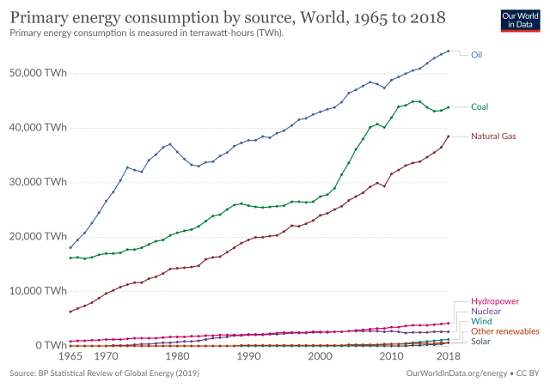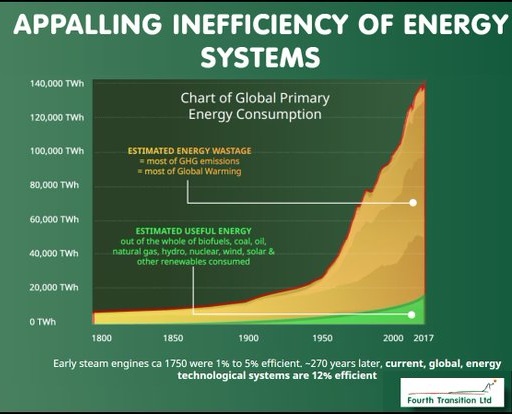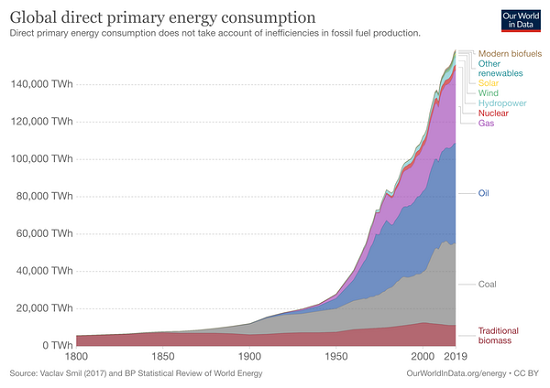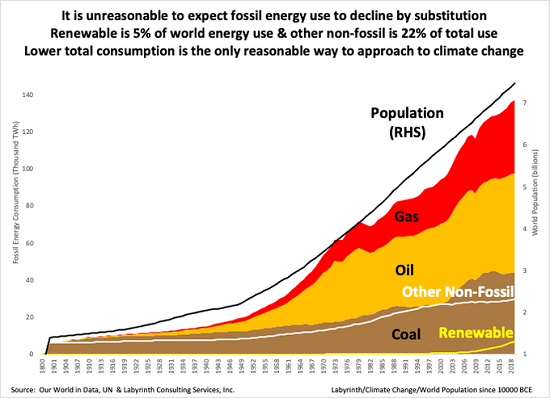
Modification the rewards, and the outcomes alter.
Ecologist Howard Odum supplied an extensive insight into human growth, stagnancy and collapse. He argued that human beings are wired to maximize power output (i.e., consumption) instead of make the most of effectiveness.
In other words, human beings are wired to remove the tree of every ripe fruit and throw a party, have more kids and utilize the surplus food to feed an army of conquest. Effective use of resources is just not part of what I term Wetware 1.0, the set of tools that was picked and optimized over the past 200,000 years for little hunter-gatherer tribes wandering an apparently near-infinite world.
We’ve misused the surpluses made it possible for by hydrocarbons to take full advantage of energy output (intake) rather than achieve efficiency. That is lastly coming around to haunt the whole “limitless development on a finite world” status quo.
Here’s the delighted story being promoted by the status quo: we can keep overconsuming/ losing resources on a vast scale by electrifying whatever that is currently powered by hydrocarbons: The Electrification of Everything: What You Need to Know.
There are an excellent lots of issues with this fantasy. One is that per Odum, humankind doesn’t replace hydrocarbons with wind-solar, it consumes all the alt-energy being added, too. Adding energy simply increases consumption.
Another is that the amount of scarce minerals and resources required to change hydrocarbons with so-called renewable energy is so huge that it’s impractical.
As I have actually noted many times, per analyst/educator Nate Hagens, “renewables” are really ‘replaceables’, as solar panels and wind turbines wear out and need to be replaced every 20-25 years, if not faster.
The scale of energy consumption is so vast and the percentage provided by solar and wind is so unimportant. Most charts swelling solar and wind with hydropower and biofuels (wood), but wind and solar supply at best 3% of international energy, after all the tens of billions of dollars that have been invested.
To provide the majority of international energy usage, we ‘d need to increase solar-wind 20-fold, from 3% to 60%. The problem, as Tim Watkins explains, is the Earth does not have sufficient limited minerals to develop this monstrous global system, and then replace it every 20-25 years: Are you still purchasing this?
“Net-zero carbon dioxide by 2050 would require the release of ~ 1500 wind turbines (2.5 MW) over ~ 300 square miles, every day starting tomorrow and continuing to 2050.”
“Obstacles of using ‘green energy’ to power electrical automobiles: If wind farms are selected to produce the power for the forecasted two billion automobiles at UK typical use, this needs the equivalent of an additional years’ worth of overall worldwide copper supply and 10 years’ worth of international neodymium and dysprosium production to develop the windfarms.”
“To change all UK-based automobiles today with electrical cars, assuming they use the most resource-frugal next-generation NMC 811 batteries, would take 207,900 tonnes cobalt, 264,600 tonnes of lithium carbonate (LCE), a minimum of 7,200 tonnes of neodymium and dysprosium, in addition to 2,362,500 tonnes copper. This represents, simply under two times the overall yearly world cobalt production, nearly the whole world production of neodymium, three quarters the world’s lithium production and at least half of the world’s copper production during 2018.”
Every kilogram of these scarce minerals should be mined, carried and processed with hydrocarbons.
The problem with wind and solar is intermittency: modern-day commercial economies need consistent electrical power 24/7 or they stop working. Wind and solar create power periodically, indicating they can’t create a steady supply 24/7 nor can they generate electrical power when consumers wish to use it.
So the intermittency problem becomes a storage issue: how can we keep surplus electrical energy in quantities large enough to power our large consumption when the wind dies and the sun decreases?
There are no cheap, simple answers to storage, and concepts such as converting it all to hydrogen are not realistic due to cost and security concerns. There isn’t adequate lithium and other limited minerals to build batteries for 2 billion vehicles and storage for every electrical grid in the world. (And note that lithium batteries have very restricted life-spans and need to be changed every decade, if not sooner. Extremely couple of batteries are recycled, so recycling billions of batteries is likewise a dream.)
As Gail Tverberg observes in her recent post, How the World’s Energy Problem Has actually Been Covert:
“So-called sustainable fuels tend to be very damaging to the environment in methods aside from CO2 emissions. This point is made very well in the new book Bright Green Lies: How the Environmental Motion Lost Its Method and What We Can Do About It by Derrick Jensen, Lierre Keith and Max Wilbert. It makes the point that eco-friendly fuels are not an attempt to conserve the environment. Rather, they are trying to conserve our existing industrial civilization using techniques that tend to damage the environment. Reducing forests, even if new trees are planted in their location, is especially detrimental. Alice Friedemann, in her new book, Life after Fossil Fuels: A Reality Look At Alternative Fuels, explains the high cost of these options and their dependence on fossil fuel energy.”
Many individuals I respect see thorium nuclear reactors as the answer, however like all the other propositions to replace the staggeringly large intake fueled by hydrocarbons with some other source, it’s not as easy in the real world as it is conceptually.
India has reserves of thorium and has an ambitious strategy to build thorium reactors. But the thorium nuclear fuel cycle is incredibly non-trivial, and in spite of billions of rupees invested, India has yet to complete a single massive thorium reactor– and neither has any other nation. There are seven research reactors spread worldwide, but no real power plants. India’s Ambitious Nuclear Power Plan– And What’s Getting in Its Method:
“With the commercialization and enhanced usage of renewable energy innovations, the per unit expense of electrical power produced from renewables has gone down substantially. The expense of solar energy in India right now is Rs 2.62 per unit, almost half of the per system cost of electricity being produced by the recently operational Kudankulam nuclear power plant (Rs 4.10 per system).”
The problem is we’ve based our entire global economy on taking full advantage of intake, not efficiency, so that waste = growth = maximizing earnings.
Consider this chart of energy consumption, and the chart of energy performance, which shows the dreadful inefficiency of our consumption.


Given that we incentivize revenues earned from increasing waste (i.e.”growth” ), this should not shock us.
As Tim Morgan has actually explained, our entire monetary system presumes that money-finance is the master system that controls whatever in the real life, when in fact the financial system is an overlay on the energy system. In essence, the whole financial system is nothing but abstract claims on energy that unlike energy can be constantly multiplied.
Claims (currency and financial obligation) can be produced out of thin air, however energy systems can not be produced out of thin air.
The answer isn’t to attempt to change a disastrously inefficient and inefficient system with changeable energy sources– a delusional fantasy. The response is to reserve our Wetware 1.0 programs to maximize energy output and intake in favor of maximizing energy effectiveness and preservation.
There are a variety of methods this transition might be made. For example, instead of tax human labor, we might tax the intake of non-renewable resources.
UnTax– Taxing Away Environment Modification:
“Yet the reason for this inertia is basic: the rate we spend for nonrenewable fuel sources, and many other non-renewable resources, is far too low, since we don’t pay for their production which took numerous millions of years, however just for their extraction. To make matters worse, more than 90% of all taxes are paid on labor in a lot of countries, which dissuades work and forces automation into every part of the economy.
This mix-up, a spin-off of the commercial transformation, causes pollution, greenhouse gas emissions, waste production and the unnecessary usage of automation, which harms our ecosystems and at the same time denies future generations of their right to gain access to those scarce resources.”
Do we actually want to go back to the “regular” of waste = growth = making the most of revenue if this “normal” is ruining the world?
Cutting intake is anathema in the current state of mind of waste = development = making the most of revenue, but the Pareto Circulation suggests we might cut consumption by 80% and still keep 80% of the fundamentals for an excellent life such as clean water, healthy food, basic shelter, and so on
. As I published in Musings # 9, consider this short film of Market Street in downtown San Francisco shot a few days before the disastrous earthquake and fire of 1906. A journey down Market Street prior to the fire (Library of Congress).
Life was pretty good in 1906 San Francisco and lots of other cities. Now take a look at the energy usage around 1900: it was around 15 TWh compared to today’s 160 TWh, roughly 10% of present consumption. And the engines and makers of 1906 were by today’s standards exceptionally ineffective. Adjust for increases in population and efficiency and it’s clear lower-consumption life is not always a go back to residing in caverns.


< img align ="center"src= "https://www.oftwominds.com/photos2021/energy-sources-berman5-21a.png"/ > Do we truly want to return to” regular “if “regular”is damaging the world?
Waste is everywhere in our lifestyle due to the fact that waste is profitable in the present arrangement. What would take place if waste was taxed at really high rates and efficiency was the sole means of making the most of revenues?
Charlie Munger (head of Berkshire Hathaway) notoriously said: “Show me the incentive and I will reveal you the result.” That’s how humans operate: we respond to the incentives presented, even if they damage the planet.
Change the incentives, and the results alter. What if effectiveness and conservation earned the most significant benefits and human labor was devoid of tax? The outcomes would enhance very dramatically– and that’s just the start.
This essay was very first published as a weekly Musings Report sent out specifically to customers and clients at the $5/month ($54/year) and greater level. Thank you, customers and subscribers, for supporting my work and free website.
If you found worth in this material, please join me in seeking solutions by ending up being a $1/month client of my work by means of patreon.com.
My brand-new book is readily available! A Hacker’s Teleology: Sharing the Wealth of Our Shrinking Planet 20% and 15% discounts (Kindle $7, print $17, audiobook now available $17.46)
Read excerpts of the book free of charge (PDF).
The Story Behind the Book and the Intro.
Recent Podcasts:
Charles Hugh Smith on the Period of Accelerating Expropriations (38 minutes) (FRA Roundtable Insight)
Covid Has Actually Activated The Next Great Financial Crisis (34:46)
My recent books:
A Hacker’s Teleology: Sharing the Wealth of Our Diminishing Planet (Kindle $8.95, print $20, audiobook $17.46) Check out the first area totally free (PDF).
Will You Be Richer or Poorer?: Earnings, Power, and AI in a Traumatized World
(Kindle $5, print $10, audiobook) Read the first area totally free (PDF).
Pathfinding our Destiny: Avoiding the Last Fall of Our Democratic Republic ($5 (Kindle), $10 (print), ( audiobook): Check out the first area totally free (PDF).
The Adventures of the Consulting Philosopher: The Disappearance of Drake $1.29 (Kindle), $8.95 (print); read the very first chapters totally free (PDF)
Money and Work Unchained $6.95 (Kindle), $15 (print) Check out the very first section free of charge (PDF).
End up being a $1/month client of my work through patreon.com.
NOTE: Contributions/subscriptions are acknowledged in the order got. Your name and email remain confidential and will not be offered to any other individual, business or firm.
|
Thank you, Katerina L. ($54), for your magnificently generous contribution to this site– I am significantly honored by your support and readership. |
Thank you |
, John D. ($50), for your splendidly generous contribution to this website– I am considerably honored by your steadfast assistance and readership. |

